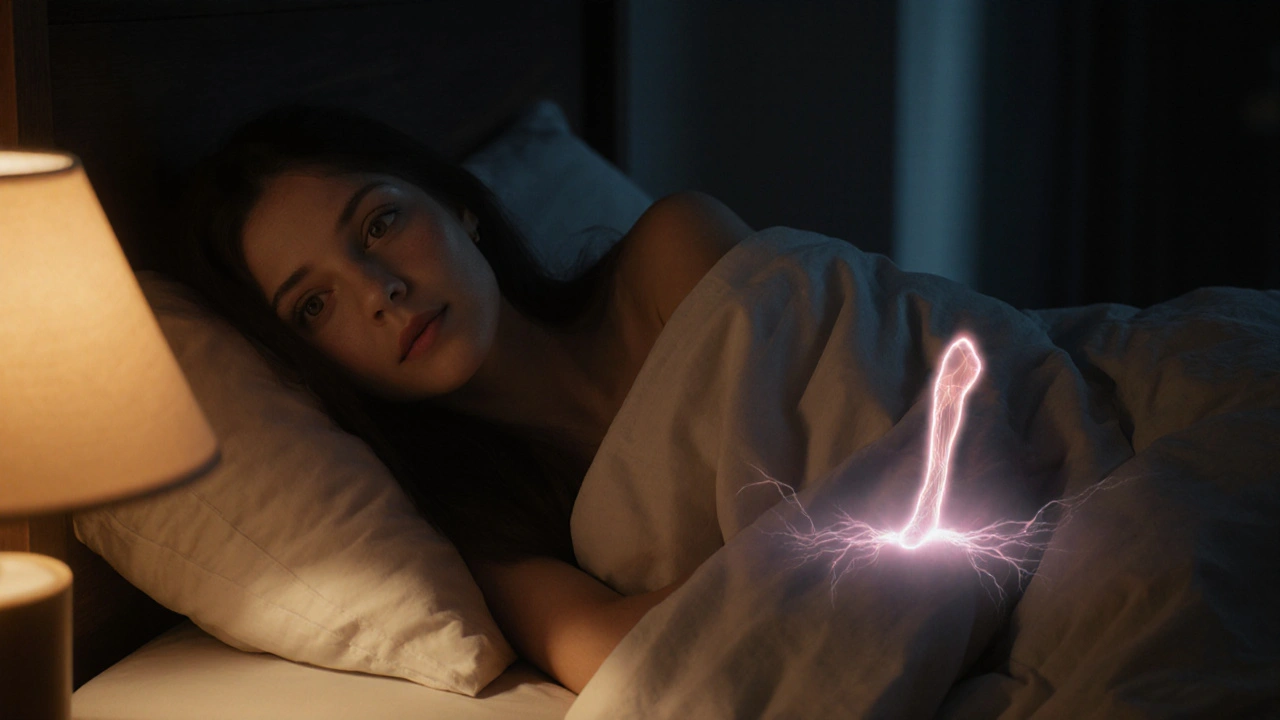Restless Leg Syndrome and Anxiety: Understanding Their Connection

Quick Take
- Restless Leg Syndrome (RLS) often co‑exists with anxiety, amplifying discomfort for both conditions.
- Both share brain chemistry clues-especially dopamine and iron levels.
- Sleep loss, stress hormones, and daytime stress create a feedback loop.
- Targeted lifestyle tweaks, CBT, and the right meds can break the cycle.
- If symptoms disrupt daily life or sleep, professional help is essential.
What is Restless Leg Syndrome?
Restless Leg Syndrome is a neurological disorder characterized by an uncontrollable urge to move the legs, usually accompanied by tingling, crawling, or burning sensations. The symptoms intensify during periods of inactivity and are most noticeable in the evenings or at night.
While the exact cause remains unclear, research points to dopamine dysregulation and low iron stores in the brain as primary drivers. Episodes often lead to fragmented sleep, which can exacerbate mood disturbances, including anxiety.
Understanding Anxiety
Anxiety refers to a group of mental‑health conditions marked by persistent worry, tension, and physical symptoms such as rapid heartbeat, muscle tightness, and restlessness. It triggers the body’s fight‑or‑flight response, releasing stress hormones like cortisol that affect many bodily systems.
When anxiety spikes, it can heighten the perception of uncomfortable sensations, turning a mild leg twitch into a distressing episode. In turn, chronic leg discomfort can keep the nervous system on high alert, feeding back into anxiety.
The Biological Link Between RLS and Anxiety
Three main biological pathways explain why RLS and anxiety often travel together:
- Dopamine - Dopamine is a neurotransmitter that regulates movement and mood. Low dopamine activity can cause the restless sensations of RLS and also lower the brain’s ability to buffer stress, making anxiety more likely.
- Iron deficiency - Iron is a co‑factor for dopamine synthesis. Iron deficiency in the central nervous system reduces dopamine production, linking both conditions at a chemical level.
- Stress hormones - Chronic anxiety raises cortisol and adrenaline, which can increase muscle tension and worsen RLS leg movements, especially at night.
These overlapping mechanisms form a vicious cycle: anxiety spikes → hormone surge → leg symptoms intensify → sleep loss → more anxiety.

Overlapping Symptoms: RLS vs. Anxiety
Both disorders share several physical cues, making it easy to mistake one for the other. The table below highlights the most common overlaps and where they diverge.
| Symptom | Restless Leg Syndrome | Anxiety |
|---|---|---|
| Leg urge to move | Strong, often at night | May occur, usually part of overall restlessness |
| Tingling or crawling sensation | Typical | Rare, unless neuropathy present |
| Difficulty falling asleep | Common due to leg discomfort | Common due to racing thoughts |
| Rapid heartbeat | Uncommon | Frequent during panic episodes |
| Muscle tension | May increase with leg movements | Widespread, not limited to legs |
| Daytime fatigue | Often from poor sleep | Can result from sleeplessness or mental strain |
Managing Both Conditions Simultaneously
Because RLS and anxiety reinforce each other, an integrated approach works best. Below are evidence‑based strategies that hit both targets.
- Iron supplementation: If blood tests show ferritin below 50µg/L, a low‑dose iron supplement (e.g., 65mg elemental iron daily) can raise brain iron stores and improve dopamine function.
- Exercise timing: Light aerobic activity-like a brisk 20‑minute walk-early in the day reduces leg restlessness. Avoid vigorous workouts within three hours of bedtime, as they may boost cortisol.
- Sleep hygiene: Keep the bedroom cool (18‑20°C), dim lights after 9p.m., and use a weighted blanket to calm the nervous system.
- Cognitive Behavioral Therapy (CBT): Cognitive Behavioral Therapy teaches coping skills that lower anxiety, which in turn lessens nocturnal leg urges.
- Medication: For moderate‑to‑severe cases, doctors may prescribe gabapentin, pregabalin, or dopamine agonists (e.g., ropinirole). These drugs can address both the sensory component of RLS and the heightened arousal linked to anxiety.
- Mind‑body techniques: Practices such as progressive muscle relaxation, guided imagery, or yoga nidra can lower cortisol levels before sleep.
- Avoid triggers: Caffeine, nicotine, and alcohol worsen dopamine fluctuations and increase anxiety. Reduce or eliminate these substances, especially after dinner.
Track your symptoms in a simple journal: note leg sensations, anxiety scores (0‑10), sleep duration, and any triggers you suspect. Patterns often emerge, guiding you toward the most effective tweaks.
When to Seek Professional Help
If any of the following apply, schedule a visit with a health‑care provider:
- Leg symptoms persist despite lifestyle changes for more than three weeks.
- Sleep loss exceeds two hours per night on a regular basis.
- Anxiety interferes with work, relationships, or daily functioning.
- You notice worsening depression, panic attacks, or thoughts of self‑harm.
A primary‑care physician can order ferritin and iron studies, refer you to a neurologist for RLS, and connect you with a psychologist or psychiatrist for anxiety management. Early intervention often prevents the spiral into chronic insomnia and severe mood disorders.
Frequently Asked Questions
Can anxiety cause Restless Leg Syndrome?
Anxiety doesn’t directly cause RLS, but it can aggravate the symptoms. Stress hormones increase muscle tension and disrupt sleep, making the leg sensations feel more intense.
Is iron supplementation safe for everyone with RLS?
Only people with documented low iron stores should supplement, as excess iron can be harmful. A blood test for ferritin is the first step before starting any supplement.
What non‑medication strategies work best?
Consistent sleep hygiene, moderate daytime exercise, iron‑rich diet, and CBT have the strongest evidence. Combining two or three of these usually yields noticeable relief within weeks.
Can a dopamine agonist treat both RLS and anxiety?
Dopamine agonists such as ropinirole primarily target RLS. Some patients report reduced anxiety secondary to better sleep, but they are not a primary anti‑anxiety medication.
How long does it take to see improvement after starting treatment?
Lifestyle changes can show benefits in 1‑2 weeks. Iron supplementation may take 4‑6 weeks to raise ferritin sufficiently. Medications often start working within a few days, but full effect may need 2‑3 weeks.
Understanding the dance between Restless Leg Syndrome and anxiety empowers you to break the loop. By tackling the shared biology, improving sleep, and using evidence‑based therapies, you can reclaim restful nights and calmer days.